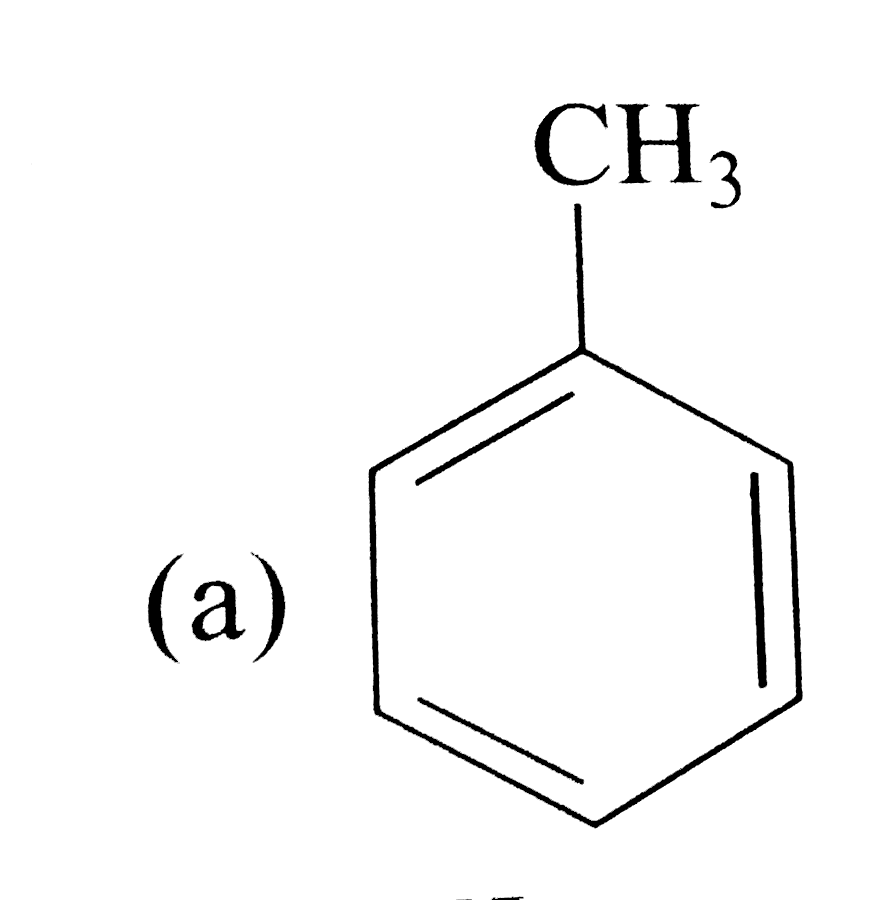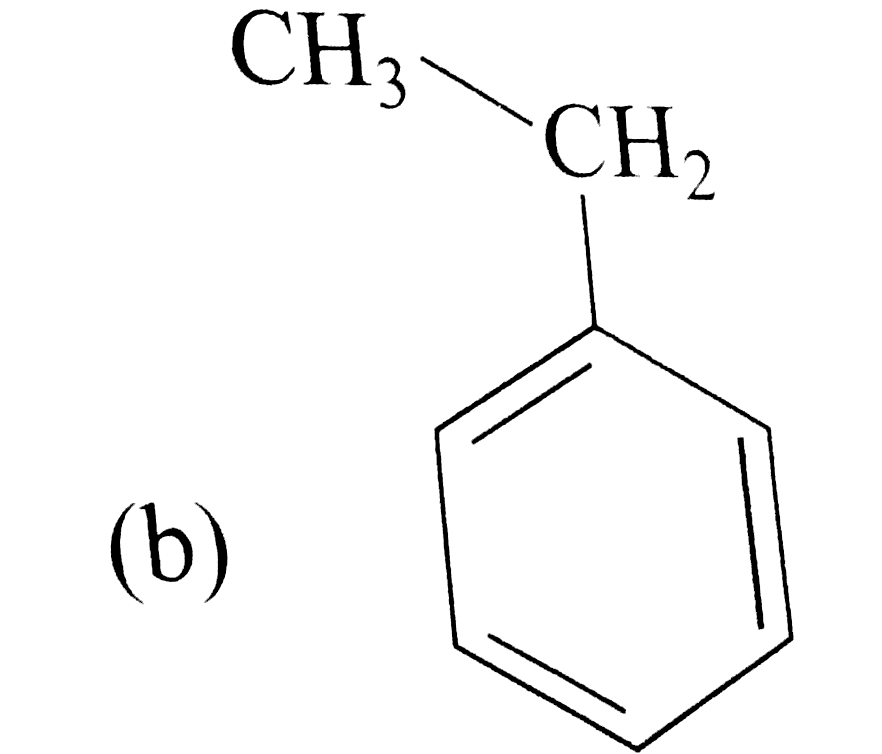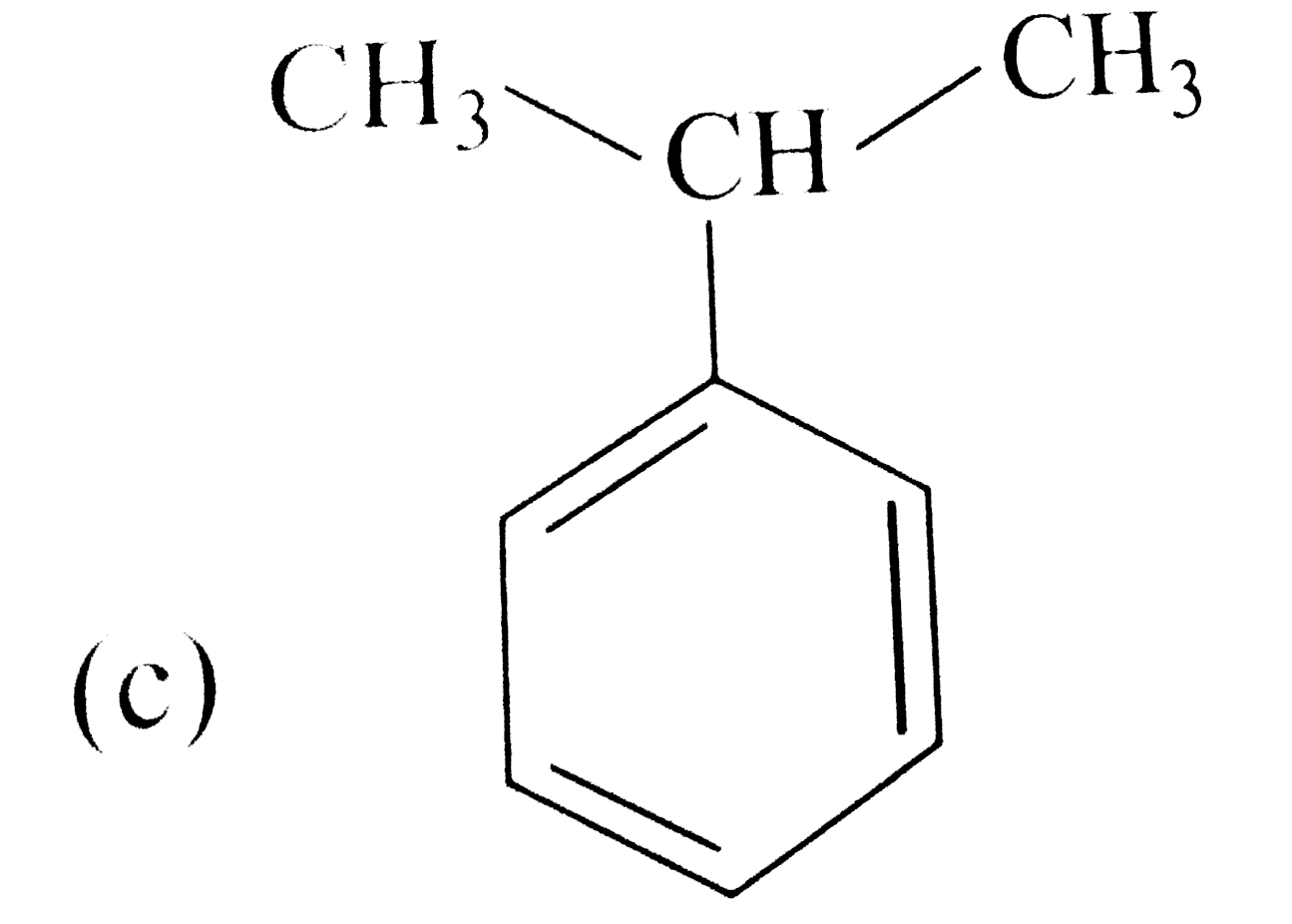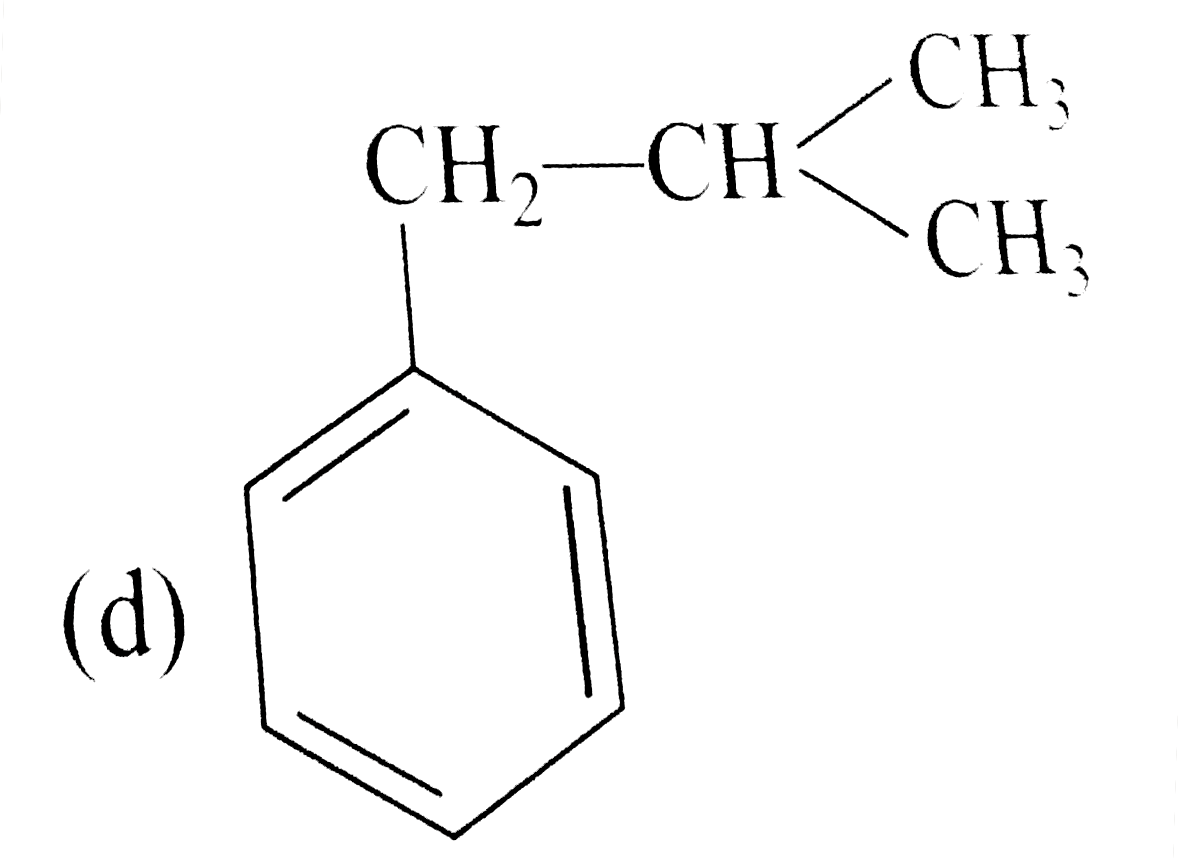Free redical halogenation takes place in presence of light or at high temperature (above 500∘C). Formation of halogen free radical intermediate takes place in first step called chain initiation step.
Cl2hv−−→2Cl∗
This reaction is mainly given by those compounds which have at least one hydrogen atom present at sp3 -hybrid carbon. Reactivity of sp3-hybrid carbon depends on the reactivity of reaction intermediate.
The relative rate of formation of alkyl radicals by a chlorine radical is:
Tertiary(5)>Secondary(3.8)>Primary(1)
Percentage yield of the product=Relative amount×100Sum of relative amounts
Relative amount=Number of hydrogen atoms on the respective carbon×relative reactivity.
NBS(N-bromosuccinimide) is used for bromination at allylic and benzylic carbon, whereas Br2/hv gives bromination at benzylic, allylic and allyl carbons.
Select most reactive compound for chlorination in presence of light:




Step by step video & image solution for Free redical halogenation takes place in presence of light or at high temperature (above 500^(@)C). Formation of halogen free radical intermediate takes place in first step called chain initiation step. Cl_(2)overset(hv)rarr2Cl^(**) This reaction is mainly given by those compounds which have at least one hydrogen atom present at sp^(3) -hybrid carbon. Reactivity of sp^(3)-hybrid carbon depends on the reactivity of reaction intermediate. The relative rate of formation of alkyl radicals by a chlorine radical is: underset("(5)")("Tertiary")gtunderset("(3.8)")("Secondary")gtunderset("(1)")("Primary") "Percentage yield of the product"=("Relative amount"xx100)/("Sum of relative amounts") "Relative amount"="Number of hydrogen atoms on the respective carbon"xx"relative reactivity". NBS(N-bromosuccinimide) is used for bromination at allylic and benzylic carbon, whereas Br_(2)//hv gives bromination at benzylic, allylic and allyl carbons. Select most reactive compound for chlorination in presence of light: by Chemistry experts to help you in doubts & scoring excellent marks in Class 12 exams.
Updated on:21/07/2023Topper's Solved these Questions
- BASIC PRINCIPLES OF ORGANIC COMPOUNDS (MECHANISM OF ORGANIC REACTIONS)BOOK - OP TANDONCHAPTER - BASIC PRINCIPLES OF ORGANIC COMPOUNDS (MECHANISM OF ORGANIC REACTIONS)EXERCISE - PASSAGE-V
5 Videos
- BASIC PRINCIPLES OF ORGANIC COMPOUNDS (MECHANISM OF ORGANIC REACTIONS)BOOK - OP TANDONCHAPTER - BASIC PRINCIPLES OF ORGANIC COMPOUNDS (MECHANISM OF ORGANIC REACTIONS)EXERCISE - SINGLE INTEGER ANSWER TYPE QUESTIONS
4 Videos
- BASIC PRINCIPLES OF ORGANIC COMPOUNDS (MECHANISM OF ORGANIC REACTIONS)BOOK - OP TANDONCHAPTER - BASIC PRINCIPLES OF ORGANIC COMPOUNDS (MECHANISM OF ORGANIC REACTIONS)EXERCISE - PASSAGE-III
5 Videos
- BASIC PRINCIPLESBOOK - OP TANDONCHAPTER - BASIC PRINCIPLESEXERCISE - SECTION V INTEGER ANSWER TYPE QUESTION
3 Videos
- CARBOXYLIC ACIDS AND THEIR DERIVATIVESBOOK - OP TANDONCHAPTER - CARBOXYLIC ACIDS AND THEIR DERIVATIVESEXERCISE - Integer
4 Videos
Similar Questions
The electronic displacements in covalent bonds may occur either in the ground state under the influence of an atom or a substituent group or in presence of an appropriate attacking reagent. As a result of these electron displacements, centres of different electron densities are created and these centres are susceptible to attack by the reagents. These electron displacements occur through inductive electromeric, resonance and hyperconjugation effects. Whereas inductive effect involves displacement of sigam-electrons towards the substituent, resonance effect involves delocalization of π−electrons transmitted through the chain and both are permanent effect. Electromeric effect is the complete transfer of a shared pair of π- electrons to one of the atoms joined by a multiple bond on the demand of an attacking reagent. Hyperconjugation effects on the other hand involve delocalization of σ-electrons of C−H bond of an alkyl group directly attached to an atom of unsaturated system (i.e., σ−π-conjugation). Both inductive and hyperconjugation effects can be used to explain the stability of carbocations and free radicals which follow the stability order : 3∘>2∘>1∘. The stability or carbanions, however, follows the reverse order.
An organic reaction occurs through making and breaking of bonds. The breaking of a covalent bond may occur either homolytic leading to the formation of free radicals or heterolytic forming positively (carbocations) or negatively (carbanions) charged species. Most of the attacking reagents carry either a positive or a negative charge. The positively charged species with electron deficient centre or neutral species (free radicals, carbenes, nitrene) are collectively called electrophiles, while negatively charged species with electron rich centre or neutral species (like water, alcohol, ammonia, etc.) are called nucleophiles.
Which of the following groups has highest inductive effect?
View SolutionAmongst following the total number of electrophiles is:
Cl+,OH−,CN−,H+,H3O+,Na+,R−,NO+2,:CH2,:NH3
View SolutionHyperconjugation describes the orbital interactions between the π-system and the adjacent σ-bond of the substituent group(s) in organic compounds. Hyperconjugation is called as Baker and Nathan effect. The necessary and sufficient conditions for the hyperconjugation are:
(i) Compound should have at least one sp2-hybrid carbon of either alkene, carbocation or alkyl free radical.
(ii) α-carbon with respect to sp2 -hybrid carbon should have at least one hydrogen.
Hyperconjugation are of three types:
(i) σ(C−H),π-conjugation,
(ii) σ(C−H), positive charge conjugation,
(iii) σ(C−H), odd electron conjugation.
The hyperconjugation may be represented as,


Number of resonating structures due to hyperconjugation =(n+1), where n is the numebr of α-hydrogen. Greater is the number of such forms, more is the stability of the species under consideration.
Hyperconjugation is possible in which of the following species?
View SolutionIn the Avogadro's number 6.023×1023 the number of significant figures will be:
View SolutionHow many different condensation products would be form by the given reaction?
CH3−O∣∣C−OC2H5+CH2−O∣∣C−OC2H5C2H5−O+Na−−−−−−→C2H5OH
View SolutionOrganic reactions take place through the formations of reactive carbon intermediates formed by cleavage of covalent bonds. Formation of these intermediates depends upon the dissociation energies of covalent bonds. 1. Which is not the intermediate formed by cleavage of covalent bonds.
View SolutionOrganic reactions take place through the formations of reactive carbon intermediates formed by cleavage of covalent bonds. Formation of these intermediates depends upon the dissociation energies of covalent bonds. 3. In the following diagram, stability of different radicals have been represented. These can be Match the potential curve with free radical
View SolutionOrganic reactions take place through the formations of reactive carbon intermediates formed by cleavage of covalent bonds. Formation of these intermediates depends upon the dissociation energies of covalent bonds. Which is most stable carbocation ?
View SolutionOrganic reactions take place through the formations of reactive carbon intermediates formed by cleavage of covalent bonds. Formation of these intermediates depends upon the dissociation energies of covalent bonds.
In which cases, free radicals can be formed by homolytic fission ?
View SolutionHunsdiecker reaction involve free radical in intermediate steps.
View SolutionFree radical halogenation takes place in the presence of light or at high temperature (abov 773K.) Formation of halogen free radical intermediate takes place in first step called chain initiation step.
CI2hv−−→2CI
This reaction is mainly given by those compound which have atleast one hydrogen atom present at sp3−hybrid carbon.
Reactivity of sp3−hybrid carbon depends on the reactivity of reaction intermediate.
The relative rate of formation of alkyl radicals by a chlorine radical is :
Tertiary(5)>Secondary(3.8)>Primary(1)
Percentage yield of the prodcut =Relative amount×100Sum of relative amounts
Relative amount = Number of hydrogen atoms on the respective carbon × relative reactivity.
NBS (N-bromo succinimide) is used for bromination at allylic and benzylic carbon, whereas Br2/hv gives bromination at benzylic allylic and alkyl carbon.
Select most reactive compound for chlorination in presence of light :
View SolutionFree radical halogenation takes place in the presence of light or at high temperature (abov 773K.) Formation of halogen free radical intermediate takes place in first step called chain initiation step. CI_(2)overset(hv)(to)2CI This reaction is mainly given by those compound which have atleast one hydrogen atom present at sp^(3)- hybrid carbon. Reactivity of sp^(3)- hybrid carbon depends on the reactivity of reaction intermediate. The relative rate of formation of alkyl radicals by a chlorine radical is : underset((5))("Tertiary") gt underset((3.8))("Secondary") gt underset((1))("Primary") " Percentage yield of the prodcut "=("Relative amount"xx100)/("Sum of relative amounts") Relative amount = Number of hydrogen atoms on the respective carbon xx relative reactivity. NBS (N-bromo succinimide) is used for bromination at allylic and benzylic carbon, whereas Br_(2)//hv gives bromination at benzylic allylic and alkyl carbon. CH_(3)CH_(2)CH_(2)CH_(3)+CI_(2)overset(hv)underset("Light")(to) underset("2-Chlorobutane")(CH_(3)overset(O)overset(|)CHCH_(2)CH_(3))+underset("1-Chlorobutane")(CH_(3)CH_(2)CH_(2)CI) Percentage yield of 2-chlorobutane will be:
View SolutionFree radical halogenation takes place in the presence of light or at high temperature (abov 773K.) Formation of halogen free radical intermediate takes place in first step called chain initiation step. CI_(2)overset(hv)(to)2CI This reaction is mainly given by those compound which have atleast one hydrogen atom present at sp^(3)- hybrid carbon. Reactivity of sp^(3)- hybrid carbon depends on the reactivity of reaction intermediate. The relative rate of formation of alkyl radicals by a chlorine radical is : underset((5))("Tertiary") gt underset((3.8))("Secondary") gt underset((1))("Primary") " Percentage yield of the prodcut "=("Relative amount"xx100)/("Sum of relative amounts") Relative amount = Number of hydrogen atoms on the respective carbon xx relative reactivity. NBS (N-bromo succinimide) is used for bromination at allylic and benzylic carbon, whereas Br_(2)//hv gives bromination at benzylic allylic and alkyl carbon. which one of the following compounds will react with NBS?
View SolutionFree radical halogenation takes place in the presence of light or at high temperature (abov 773K.) Formation of halogen free radical intermediate takes place in first step called chain initiation step.
CI2hv−−→2CI
This reaction is mainly given by those compound which have atleast one hydrogen atom present at sp3−hybrid carbon.
Reactivity of sp3−hybrid carbon depends on the reactivity of reaction intermediate.
The relative rate of formation of alkyl radicals by a chlorine radical is :
Tertiary(5)>Secondary(3.8)>Primary(1)
Percentage yield of the prodcut =Relative amount×100Sum of relative amounts
Relative amount = Number of hydrogen atoms on the respective carbon × relative reactivity.
NBS (N-bromo succinimide) is used for bromination at allylic and benzylic carbon, whereas Br2/hv gives bromination at benzylic allylic and alkyl carbon.
Arrange decreasing order of reactivity of given compounds with NBS :(N-bromo succinimide)
I.C6H5−CH3
II.C6H5−CH2−CH2CH3
III.C6H5−CH2−CH=CH2
IV.C6H5−CH∣CH3−CH=CH2
Select the correct answer from the codes given below
Codes:
View SolutionFree radical halogenation takes place in the presence of light or at high temperature (abov 773K.) Formation of halogen free radical intermediate takes place in first step called chain initiation step.
CI2hv−−→2CI
This reaction is mainly given by those compound which have atleast one hydrogen atom present at sp3−hybrid carbon.
Reactivity of sp3−hybrid carbon depends on the reactivity of reaction intermediate.
The relative rate of formation of alkyl radicals by a chlorine radical is :
Tertiary(5)>Secondary(3.8)>Primary(1)
Percentage yield of the prodcut =Relative amount×100Sum of relative amounts
Relative amount = Number of hydrogen atoms on the respective carbon × relative reactivity.
NBS (N-bromo succinimide) is used for bromination at allylic and benzylic carbon, whereas Br2/hv gives bromination at benzylic allylic and alkyl carbon.
Chlorinating agent for free radical chlorination may be taken as :
View Solution
